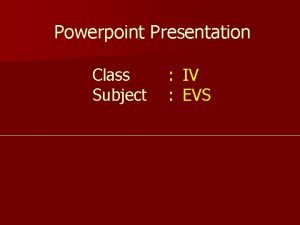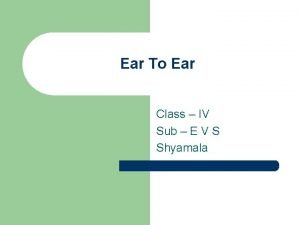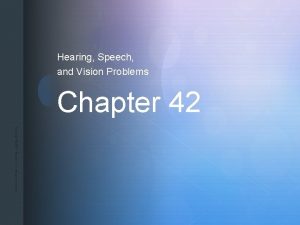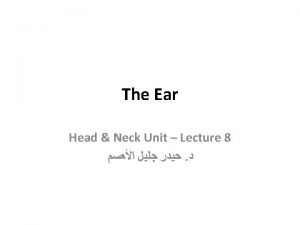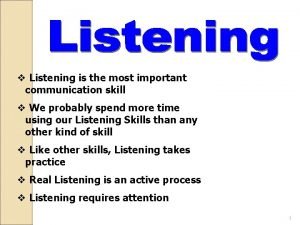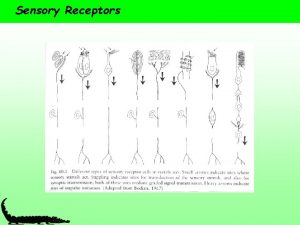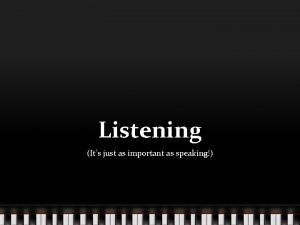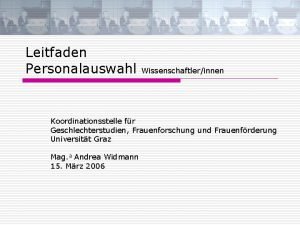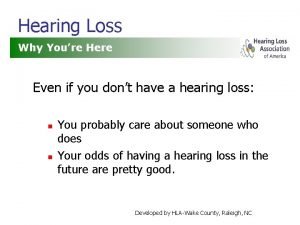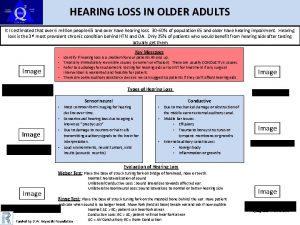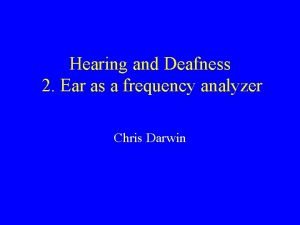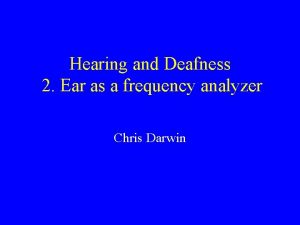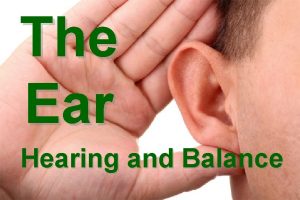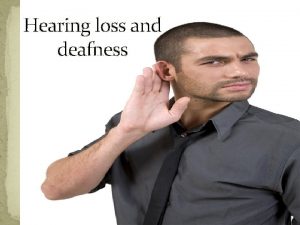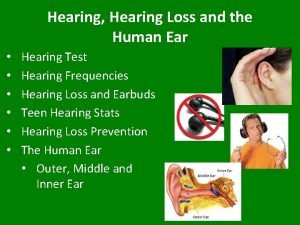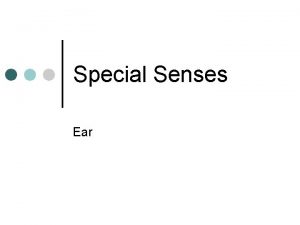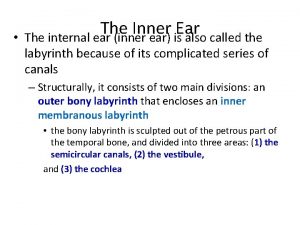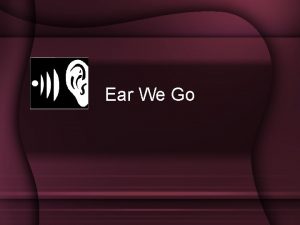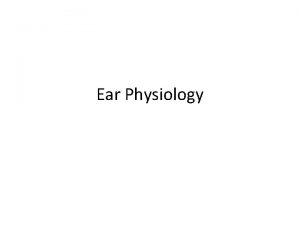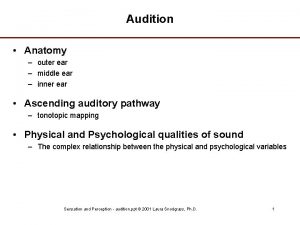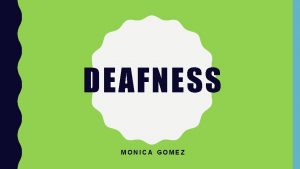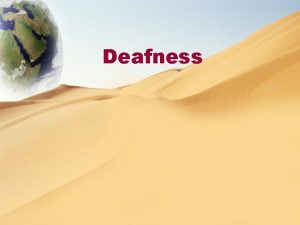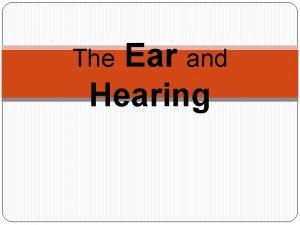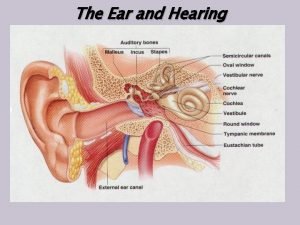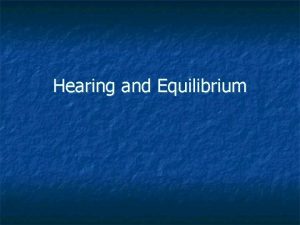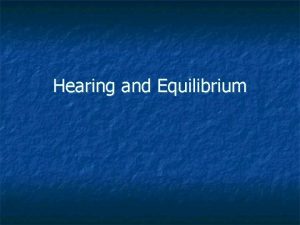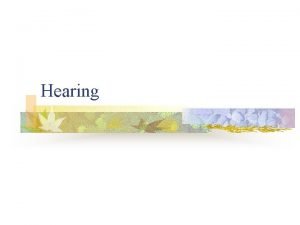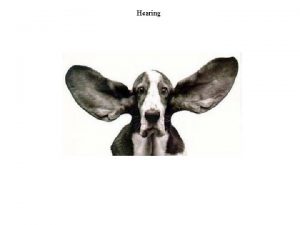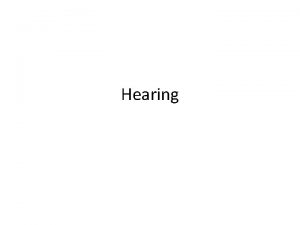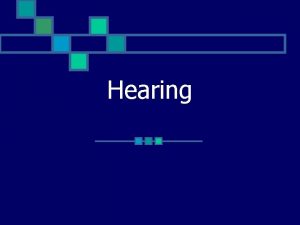Hearing and Deafness 2 Ear as a frequency






























- Slides: 30

Hearing and Deafness 2. Ear as a frequency analyzer Chris Darwin

Frequency: 100 -Hz Sine Wave 1. 0 Spectrum 0 Amplitude against frequency -1. 0 0 Time (s) Waveform 0. 05 1 amp Amplitude against time 100 Hz frequency

Frequency: 500 -Hz Sine Wave 1. 0 Spectrum 0 Amplitude against frequency -1. 0 0 Time (s) 0. 05 1 Waveform amp Amplitude against time frequency 100 500 frequency

Amplitude: 500 -Hz Sine Wave Spectrum Amplitude against frequency 0 1 0 Time (s) 0. 05 amp frequency 100 0 0 Time (s) 0. 05 500 frequency

Phase: 500 -Hz Sine Wave sine The amplitude spectrum does not show phase 1 amp cosine frequency 100 500 frequency

adding sine waves Spectrum of Sum 1 amp frequency 1 amp

100 -Hz fundamental Complex Wave 5. 0 Spectrum Amplitude against frequency 0 -1. 7 0 Time (s) Waveform 0. 05 1 amp Amplitude against time frequency 100 500 frequency

Frequency Adding nine sine waves Time 5 s Frequency Spectrogram

The linear vs log scales Linear • equal distances represent equal differences 0 100 200 300 400 500 100 -1 200 0 400 1 800 2 1600 3 3200 4 Log • equal distances represent equal ratios e. g. Piano keyboard frequencies Octave = doubling of frequency basilar membrane has log repn of frequency

deci. Bel (d. B) scale Sound A is x d. B more intense than sound B when: x = 10*log 10 (energy of A / energy of B) or x = 20*log 10 (amp of A / amp of B) So if A is 20 watts and B is 10 watts x = 10*log 10 (20/10) = 10*0. 3 = 3 d. B You can usually just hear a difference of 1 d. B (jnd)

Bandpass filtering (narrow) 5. 0 1 amp 0 -1. 7 0 Time (s) 0. 05 frequency 100 500 frequency 1 amp 0 0 Time (s) 0. 05 frequency 100 500 frequency

Bandpass filtering (wide) 5. 0 1 amp 0 -1. 7 0 Time (s) frequency 100 0. 05 500 frequency 1 amp frequency 100

Beats Repetition rate is the difference in frequency between the two sine-wave components 1/3 second 505 - 500 = 5 Hz 1 amp frequency 100 500 frequency

Beats Repetition rate is the difference in frequency between the two sine-wave components 1/100 th second 500 - 400 = 100 Hz 1 amp frequency 100 400 500 frequency

Reponse of basilar membrane to sine waves Each point on the membrane acts like bandpass filter tuned to a different frequency: high freq at base, low at apex. Each point vibrates at frequency of pure tone (-> phase locking)

Excitation patterns (envelope of excitation) Basilar membrane excitation pattern is like a spectrum

Auditory filter bandwidth (ERB)

Excitation pattern of complex tone on bm

Measurement of auditory bandwidth with band-limited noise 1000 Hz 250 Hz Broadband Noise frequency 2000 Hz Amadeus

A gardening analogy

A gardening analogy

A gardening analogy Tone Noise Auditory bandwidth Noise bandwidth Detection mechanism

Wider auditory filter

Auditory tuning curves Inner hair-cell damage Healthy ear

Outer-hair cell damage

Human auditory bandwidth At 1 k. Hz the bandwidth is about 130 Hz; at 5 k. Hz the bandwidth is about 650 Hz. BW = freq / 8 roughly

Normal auditory non-linearities • Normal loudness growth (follows Weber’s Law, which is logarithmic, not linear) • Combination tones • Two-tone suppression • Oto-acoustic emissions

Conductive vs Sensori-neural deafness Mostly a combination of OHC and IHC damage Becomes linear, so No combination tones Or two-tone suppression

Symptoms of SNHL • Raised thresholds: helped by amplification • Wider bandwidths: no help possible • Recruitment (restricted dynamic range): partly helped by automatic gain controls in modern digital aids • Often accompanied by tinnitus

Normal vs Impaired Dynamic Range
 Icd 10 telinga berdenging
Icd 10 telinga berdenging An animal with ears like leaves name
An animal with ears like leaves name An animal with ear like leaves
An animal with ear like leaves Conditional relative frequency
Conditional relative frequency Expected relative frequency
Expected relative frequency Form factor and crest factor
Form factor and crest factor Vmax=aw
Vmax=aw Relative frequency bar chart
Relative frequency bar chart Joint frequency vs marginal frequency
Joint frequency vs marginal frequency Conditional frequency table
Conditional frequency table Chapter 42 hearing speech and vision problems
Chapter 42 hearing speech and vision problems The receptors for hearing are the
The receptors for hearing are the Modiolus
Modiolus Sight hearing taste smell and touch
Sight hearing taste smell and touch Family
Family Difference between hearing and listening
Difference between hearing and listening Bsc speech
Bsc speech Insulated listening definition
Insulated listening definition Barriers to communication
Barriers to communication Listening vs hearing
Listening vs hearing Classification of sensory receptors
Classification of sensory receptors What is the rising action of romeo and juliet
What is the rising action of romeo and juliet Hearing on advisement
Hearing on advisement Listening vs hearing
Listening vs hearing Hearing personalauswahl
Hearing personalauswahl If only i could fly asl story with words
If only i could fly asl story with words Kode icd tinitus
Kode icd tinitus Safetymri
Safetymri To hear with attention
To hear with attention Cookie bite hearing loss
Cookie bite hearing loss Conductive hearing loss lateralization
Conductive hearing loss lateralization

